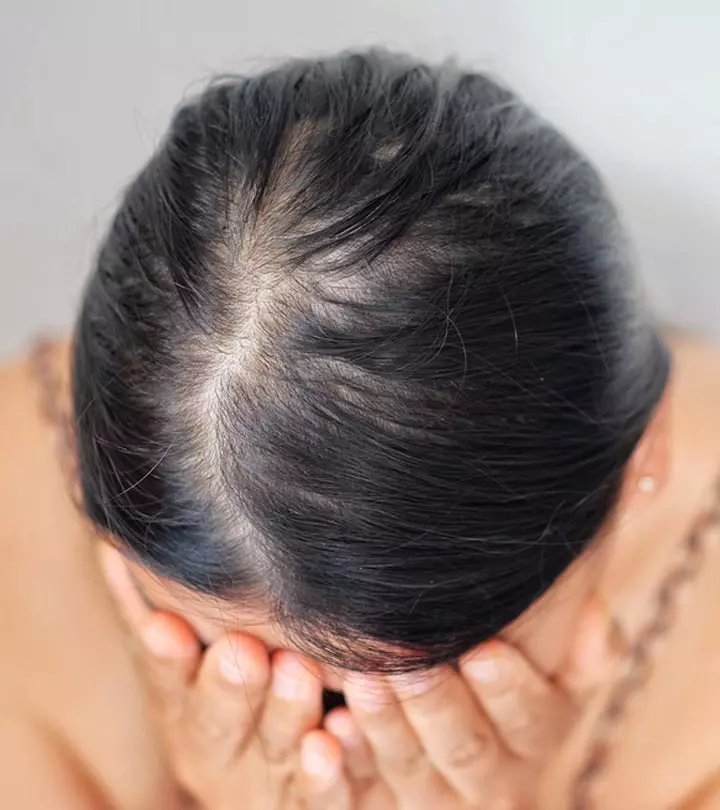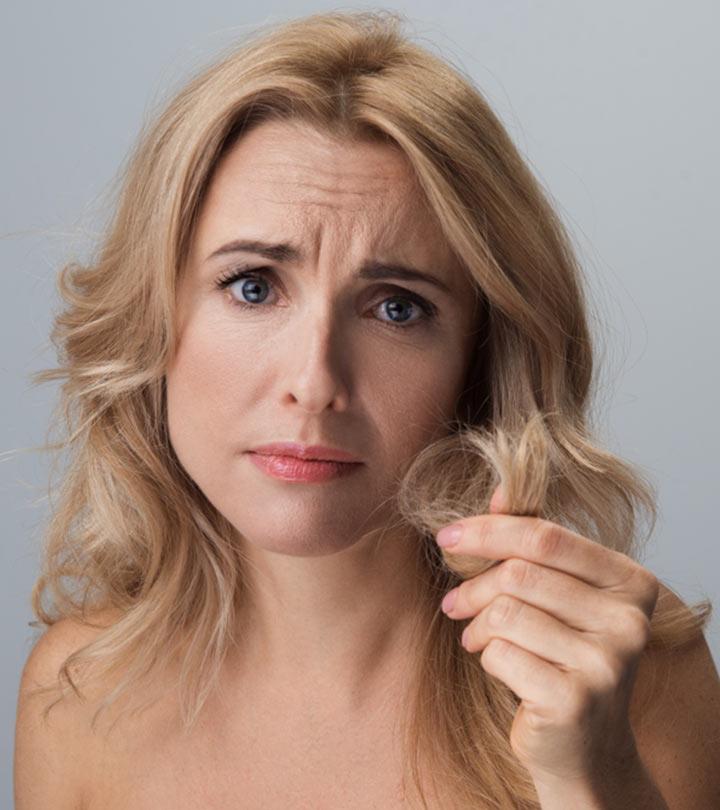8 Early Signs Of Alopecia, Diagnosis, And How To Deal With It
Recognize the early signs of alopecia for timely diagnosis and better solutions

Image: Shutterstock
Natural hair loss is a common occurrence, but that does not mean we should embrace it. The good news is you can detect early signs of alopecia or hair loss. In other words, you can potentially stop any imminent hair loss. Common signs of this condition include fragile nails and sparse eyebrows. But what else might signal a hair loss crisis? Read this article to learn more.
In This Article
Spotting The Early Signs Of Hair Loss
According to The American Academy of Dermatology Association, it is normal to lose 50-100 strands of hair every day (1). But, according to anecdotal reports, there are a few warning signs you should look out for if you suspect you are losing more hair than usual:
- Sudden Or Excessive Hair Loss
If you notice excess hair on your brush or clogging the drain regularly, it is recommended to consult a doctor. This early diagnosis can help in preventing or slowing down further hair loss.
- Receding Hairline
Loss of hair along the hairline
in men is an early sign of alopecia. Just pull your hair back from the forehead to check your hairline. If it looks further back than usual along the front or around the temples, it means your hairline is receding.
- Hair Thinning
is another sign of alopecia. If you notice sparse hair on the top of your head or circular patches of thinning hair, it could be the start of alopecia.
- Thinning Ponytail
Sudden or excessive hair loss usually results in loss of hair volume. Women experience hair loss all over the scalp. So if your ponytail is looking thinner than usual, or you can see your scalp through your hair, it is time to see a healthcare provider.
 Pro Tip
Pro Tip- Bald Patches
If you are losing patches of hair suddenly accompanied by itching or a burning sensation, you need immediate medical attention. Scalp tenderness or losing clumps of hair can indicate an underlying infection. For instance, in a ringworm infection, you will experience patchy scales on your scalp along with redness, swelling, and hair loss.
Hannah, a blogger, writes about her battle with chronic illness, alopecia, and her life in her blog. She shares her experience in her post for alopecia awareness month. She wrote, “My relationship with alopecia began when I was twenty and found a small coin shaped patch at the back of my head. At that point I wasn’t too worried and after being reassured by the doctor that it would go away, I began to forget about it. However, it didn’t go away (i).”
- Patchy Beard
Men with one or more bald patches in their beard area can be at risk for alopecia.
- Sparse Eyebrows And Eyelashes
Losing hair from the eyebrows
, eyelashes, pubic area, beard, and other parts of the body is also considered an early sign of alopecia. Such full body hair loss is known as alopecia universal is. This can also happen due to cancer treatments such as radiation therapy or chemotherapy.
- Brittle Or Red Nails
If your nails have pits, craters, or small white spots or lines, it could be an early sign of alopecia. Red nails or brittle nails can also be a warning sign for hair loss.
These are a few tell-tale signs of alopecia. Spotting them on time can help you treat them quickly. Scroll down to learn more about this condition.
Do I Have Alopecia?
If you noticed two or more of the above signs, you must consult a dermatologist for a proper diagnosis. Physical examination, laboratory tests, and biopsy will determine if you have alopecia.
There are different types of hair loss, depending on your:
- Age
- Sex
- Genetic factors
- Nutritional deficiencies
- Hormonal imbalance
- Autoimmune reaction
The treatment will differ from one type of alopecia to another. Find out what causes this condition in the next section.
What Causes Alopecia?
Alopecia is often triggered by an autoimmune response where the immune system mistakenly attacks hair follicles. This can be influenced by genetics and environmental triggers such as stress, viral infections, and certain medications. When the immune system attacks the hair follicles, the confusion activates natural killer cells and releases certain proteins. These proteins cause inflammation and affect the normal hair growth cycle. The combination of these factors may increase the risk of developing alopecia areata (2).
Knowing the cause behind hair loss can help determine the treatment. Find out the different treatment options available for alopecia in the section below.
How To Deal With It?
There are different ways to deal with hair loss.
- Medications: Some medications such as minoxidil and finasteride promote hair regrowth (3).
- Therapies: Laser therapy and micro-needling can activate hair follicles and trigger hair growth (3).
- Hair Transplant: You can use wigs or get a hair transplant to cover hair loss in extreme cases (3).
- Diet: Following a healthy diet with adequate proteins and nutrients may help in reducing hair loss (3).
 Pro Tip
Pro Tip- Hormone Replacement: If the hair loss is triggered by hormonal disturbances, you can consult a doctor for treatment (3).
If you have lost a lot of hair, you are probably one of the millions of people dealing with alopecia. It is a distressing condition for many people. Thinning hair, abrupt hair loss in patches, and brittle nails are all early indicators of alopecia. If you experience excessive hair loss, contact a dermatologist for diagnosis and to determine the best treatment strategy for moving forward with certainty. Hair loss, also known as alopecia, is a widespread issue with various causes. However, a healthy diet, medicines, wearing wigs, or getting a hair transplant can help deal with the condition.
Frequently Asked Questions
Is alopecia caused by stress?
Yes, alopecia may be caused by severe stress as research has established links between stress, hair loss, and autoimmune diseases (4), (5).
Can alopecia just be one spot?
Yes, alopecia may present as one balding spot on the scalp, eyebrow, or beard.
Is alopecia life-threatening?
While alopecia in itself is not a life-threatening disease, it may lead to severe psychological issues. Studies have shown an increased risk of death by self-harm, smoking-related diseases, and psychiatric diseases (6).
Key Takeaways
- Sudden or excessive hair loss, receding hairline, hair thinning, bald patches, and brittle nails are a few of the warning signs of alopecia.
- You can treat alopecia through medications, therapies, hair transplants, diet, or hormone replacement.
- Consulting a dermatologist will be the best idea if you think you have alopecia symptoms.
Watch the following video to explore the causes, symptoms, and treatments for alopecia. The video will help you gain insights into this condition affecting hair loss and share potential solutions to manage the condition.
Personal Experience: Source
StyleCraze's articles are interwoven with authentic personal narratives that provide depth and resonance to our content. Below are the sources of the personal accounts referenced in this article.
(i) My first guest post for #alopeciaawarenessmonthhttps://baldblogging.wordpress.com/2016/09/12/my-first-guest-post-for-alopeciaawarenessmonth/
References
Articles on StyleCraze are backed by verified information from peer-reviewed and academic research papers, reputed organizations, research institutions, and medical associations to ensure accuracy and relevance. Read our editorial policy to learn more.
- Do You Have Hair Loss Or Hair Shedding?
https://www.aad.org/public/diseases/hair-loss/insider/shedding - Alopecia Areata
https://www.ncbi.nlm.nih.gov/books/NBK537000/ - Female pattern hair loss: Current treatment concepts
https://www.ncbi.nlm.nih.gov/pmc/articles/PMC2684510/ - Hair and stress: A pilot study of hair and cytokine balance alteration in healthy young women under major exam stress
https://www.ncbi.nlm.nih.gov/pmc/articles/PMC5397031/ - Stress as a trigger of autoimmune disease
https://pubmed.ncbi.nlm.nih.gov/18190880/ - All-Cause and Cause-Specific Mortality Risks Associated With Alopecia Areata
https://jamanetwork.com/journals/jamadermatology/fullarticle/2734014
Read full bio of Dr. Shruti Chavan
Read full bio of Anjali Sayee
Read full bio of Monomita Chakraborty


























Community Experiences
Join the conversation and become a part of our empowering community! Share your stories, experiences, and insights to connect with other beauty, lifestyle, and health enthusiasts.